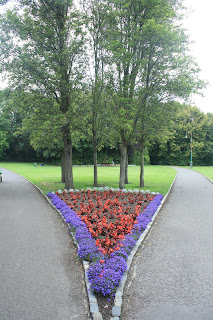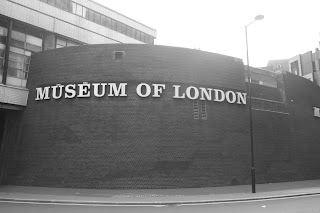 |
| The main green house at Kew |
We went to Kew gardens the other weekend, I think it was the last official day of summer and it was a fantastic day, blue skies, very slight breeze, not too hot. We got there on the overground, and you could see the houses get bigger and bigger as we got closer. People started to even have backyards, very unusual here. When we arrived most of the houses looked a little like where we are currently staying, just a big manor house, but instead of 17 families staying in the house, there is only one.
Kew Gardens is a bit expensive, for what is really just botanic gardens, but the grounds are so well cared for and it's such a nice break from the hustle of London that you don't mind too much. There are also a number of structures in the grounds which have to be maintained, so far enough really.
Kew Gardens actually consists of two gardens, the Richmond estate and the Kew Garden. When these were combined in 1802 is when what we now know as Kew Gardens was formed. This is also the reason why it is called Kew Gardens rather than just Kew Garden.

It was King George II and his wife who really began the transformation of the Richmond portion of the gardens into something resembling what we now know. Similarly it was his son Prince Frederick and his wife who did the same for the Kew Garden part of the gardens. Apparently King George II and his wife hated their son Prince Frederick, even though they were living in adjoining estates. I'm not really sure what the reason for the hatred was, most people seem to think it was fairly irrational. Apparently when Frederick first arrived in England he hadn't seen his parents for 14 years, since when he was quite young, and he became a sort of figure head for dissatisfaction with the King.
It was in 1759 that the first botanic gardens were established at Kew and after 1772 Joseph Banks became a sort of superintendent of Kew, and it was then that things really started to happen.
In 1802 King George III finally united the two gardens of Richmond and Kew, though it was really Joseph Banks' influence which meant that from the 1800's all English ships returning from any of the far-flung colonies returned with some form of specimen for planting in the gardens.
There were some interesting stories to come out from around this period. At this time China was the only place where tea was grown, there were no plantations in India yet. England really wanted to break the strangle-hold that China had on this addiction of it's people and so made many attempts to smuggle out the jealously guarded tea plants. Eventually one such collector succeeded in smuggling out a vast number of seeds which were then planted in India. Though perhaps the Chinese got their own back, at one point one of the Kings of England wanted to make his own silk farms, so
 |
Are these fox gloves?
|
the Chinese sold him 20,000 seedlings of black mulberry. It was only after these had all been planted out and were growing that it was realised that silk worms only eat white mulberry.
It seemed that there were many such stories of these collectors back then, they sounded a little like Indiana Jones, except plant collectors, which I suppose is no more fantastical than an archaeologist as a super-hero.
 |
| Slightly leaning Chinese pagoda |
The pagoda to the left was completed in 1762. This was during the period of fascination for anything oriental in Europe. Supposedly it was because these countries (being Japan and China) were forbidden to outsiders at the time. Though apparently the builders were not completely faithful to tradition, in that this one has 10 floors, when pagodas should always have an odd number of floors. During the second World War holes were drilled in each of the floors so that bombs could be dropped and their flight studied (I don't think they were the explosive kind)
 |
| The Chinese pagoda from the Japanese garden |
In keeping with the theme there is also a Japanese garden. This was built in 1996, and the designer was told to keep the following in mind when creating it:
- people would be able to approach from any direction
- there could be no water features
- not a lot of time could be spent on the maintenance
If you have ever visited gardens in Japan you could perhaps appreciate that these three rules go against everything they stand for. But the creator did a good job, and he seems to have certainly captured the spirit of Japanese gardens, even if it does feel a bit like a Japanese-British hybrid. He also managed to sneak in a water feature, not sure how he hid that one from the curators.
 |
| Bluebells!!!! |

There was even a little patch of bluebells in the grounds. Is it some sort of gardening rule that bluebells can only grow by this particular tree? I think it's an oak tree. As this was the only place we saw them growing. Are they like truffles?
 |
Who can guess what these are?
|
We saw these trees to the left all over the place. At first I thought they were conkers, but eventually we found one which still had it's name-plate. It's actually a really common Christmas treat.
 |
Australia just can't escape it's convict past, even our trees are in gaol
|
 |
One of the top 10 trees to see in Britain
|
One thing I would highly recommend is a walking tour, they only go for about an hour and are free, but they give you so much more information. I think that is what made our visit really enjoyable as we learnt so much about the history and funny stories of past curators and collectors.
Whilst on the tour the guide pointed out a small ginkgo tree, everyone in the group already knew what they were (except for us) so she didn't go into too much detail. These trees though, are the only surviving member of a group of trees which were widespread 180-200 million years ago. This particular one was planted in 1762, less than 40 years after their introduction to England from China. It is also one of the few remaining trees from the botanic gardens started by King George III's mother. These trees are pretty amazing, and can live to 3000 years old, which means the one in Kew gardens is actually just a baby.
 |
The Princess of Wales conservatory, had about 10 rooms, all with completely different climates
|
 |
Venus fly-traps!
|
I think some of the best things to see in Kew are in their various green houses. The Princess of Wales conservatory is particularly impressive in that there are about 10 different climates all housed in there. So you go from rainforest, to desert, to orchids just by walking through doors. We even got to see venus fly-traps, though it would have been more fun to see them being fed.
As well as the Princess of Wales, and the main green house, there was also a water lilly house (extremely popular), bonsai house and alpine house (nice to visit in the heat of the day).
I would recommend visiting the water lily house in the mid-morning as apparently there are two types of lilies, those that flower at night, and those that flower in the day. So by visiting then you are more likely to see all of them open. We went in the afternoon and so some of the flowers were all closed up.
 |
Black plants??
|
Obviously, being a botanic gardens, there is an active research centre on the grounds, with students studying there. These lucky students were given a section of the garden to grow whatever they wanted. I wonder if they were marked on their plants, you would think that as a botanist you wouldn't want to be killing your trees. Some of the students went for the outlandish, which is were those black plants were. I would think these must grow somewhere very cool as if these were in the Australian desert I think they would spontaneously combust.
The final thing we visited was a tree top walk, perhaps not the best tree top walk I've ever done and there is no lift access so family members had to be abandoned at the bottom, but it certainly gave you a different perspective on the big trees surrounding you.
I'll just leave you with a whole bunch of flowers. I hope they turn out alright, I'm using my phone at the moment, so don't think the full resolution is showing up. Only three more days until broadband!
 |
| Freaky flowers |
 |
| The sensory garden, I think it was for blind people |
 |
| More freaky flowers |
 |
| Who says right angles don't exist in nature? |
 |
| Yet more flowers |
 |
| Water lilies |
 |
| These could apparently hold the weight of a baby |
 |
| This should have a name like dragon's breath |
 |
| Desert plants in the Princess of Wales |
 |
| Those pebbles next to the stones are plants |
 |
| Alpine fluff-balls |
 |
| Australian alpine flowers |
 |
| The bonsai house |
 |
| Student plots |
 |
| More water-lilies |
 |
| View of the glass house from the tree top walk |





















































